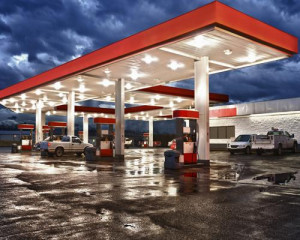Curb appeal and promotions drive fuel-only customers inside a C-store: Study
The majority of fuel sold in North America is sold at convenience stores. However, getting motorists to come inside the store after filling up has been an ongoing challenge for the convenience channel.
Citing State of the Industry data from NACS, the US-based association for convenience and fuel retailing, GasBuddy noted that a convenience store's inside sales generate almost three-quarters of all gross profit dollars. Yet, some estimate that a similar number of consumers fill up and drive away — never coming inside to make additional purchases.

Converting those forecourt customers to inside customers is not impossible. In a new study, Canopy to the Store, GasBuddy found that conversion depends on a c-store operator's ability to meet consumer needs of safety, cleanliness and hospitality. Additionally, consumers show "a strong interest" in specific strategies and promos that can move them from the pumps to the store.
First impressions count: Think curb appeal
GasBuddy released a report summarizing the findings from its surveys conducted in July 2018 and December 2018. Chief among its findings: Curb appeal matters.
Calling the forecourt "the first handshake that welcomes customers to the store," GasBuddy explained that consumers are unlikely to go inside a store if they perceive it as dirty, boring or unexceptional. Reputation matters as well.
Frequent customers cite the following factors as having a strong or moderate influence in their opinion of a store before stepping inside:
- Store design and upkeep (82.54 percent)
- Cleanliness of the fuel area (79.7 percent)
- Quality of lighting (79.6 percent)
- Brand reputation (58.6 percent)
- Opinions of friends and family (55.12 percent)
Moving inside, GasBuddy found that restrooms matter. According to the survey results, 22.6 percent of consumers said they frequently make a purchase after using the restrooms at a c-store. Another 56 percent said they occasionally make a purchase.
However, the restrooms must be clean. Nearly two-thirds of consumers said they have visited a gas station's c-store with the intention of using the restroom, but decided to leave and go elsewhere.
Top reasons for avoiding a c-store's restroom are:
- Restrooms were dirty;
- Restrooms were outdated and/or poorly maintained;
- C-store was outdated and/or poorly maintained;
- Restroom required a key or an access code; and
- Customer did not feel safe.
GasBuddy's report also revealed that knowing that a convenience retailer was committed to clean, quality restrooms would probably influence nearly 42 percent of consumers and definitely influence 27.19 percent.
"Every restroom visit is a sales opportunity. It's a chance to connect with fuel-only customers who would otherwise rarely — or never — wander inside the store. Unfortunately, retailers who provide outdated, dirty, or poorly maintained facilities are not equipped to leverage this opportunity," GasBuddy stated, calling restrooms "a litmus test for overall store quality."
Offers and promotions drive sales
Beyond the look and feel of a store, convenience store retailers need to reach fuel-only consumers where they are — on their phones. According to GasBuddy, more than half of consumers look at their smartphone while refueling and, more notably, nearly three our of four consumers aged 18 to 34.
"This opens many opportunities to drive in-store sales through relevant offers and promotions," the report noted.
Fuel discounts can hit the spot. In a recent GasBuddy study, 65 percent of consumers said gas prices impact their ability to spend money on other items and services.
Relevant orders also deliver results. When asked which kinds of mobile ads influence their decision to visit a convenience store brand, consumers said:
- Healthy food options;
- Redeemable coupons for convenience store products;
- Loyalty rewards for convenience store products; and
- Loyalty rewards for fuel savings.
The Canopy to the Store report also found that nearly 71 percent of consumers surveyed belong to a rewards program for a c-store or gas station. Of those, 48.78 percent use a rewards program very frequently, 34.2 percent somewhat frequently, 12.84 percent somewhat rarely, and only 4.17 percent very rarely.
Minimal savings and discounts on products consumers don't purchase are among the reasons why they rarely use a rewards program.
A c-store retailer can change consumers' minds, however, if the program offers consumers the ability to: build up points to spend on what they choose; earn discounts on fuel for in-store purchases; and get discounts on products they purchase daily or weekly.
To download GasBuddy's full Canopy to Store report, click here.
Originally published at Convenience Store News.
